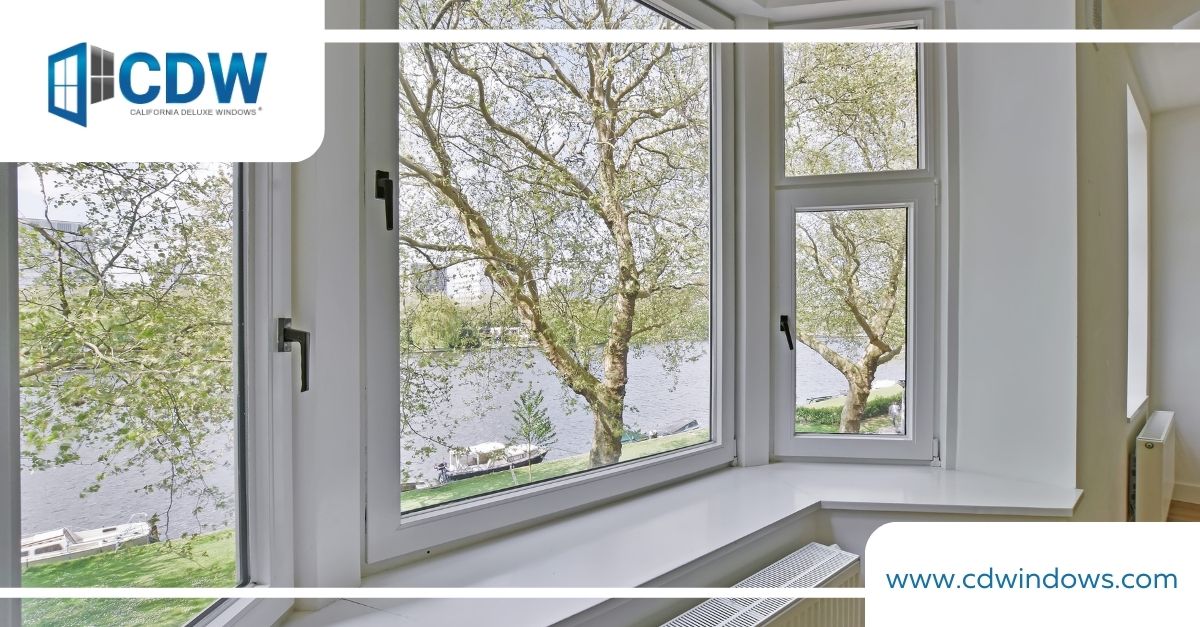The primary distinction between a single-hung and a double-hung window lies in the operability of the window sashes. A sash is the part of the window that holds the glass and can move. In single-hung windows, the top sash remains stationary, while the bottom sash moves vertically. With double-hung windows, both the top and bottom sashes can move independently, allowing for more flexibility in airflow and maintenance. Many of our clients choose both models as their California replacement windows.
But the differences go far beyond just sash movement.

Choosing the right style for your California replacement windows can affect the aesthetics, functionality, ventilation, energy efficiency, and even the maintenance of your home. One of the most common questions homeowners face when selecting new windows is whether to go with single-hung or double-hung designs.
While both are classic, timeless options that work well with a variety of architectural styles, there are key differences between them that may make one a better fit than the other for your specific needs.
How does ventilation differ between double-hung and single-hung windows?
Ventilation is one of the biggest advantages of double-hung windows. Because both sashes can move, you have the option of opening the top, the bottom, or both simultaneously.
Opening both sashes at once allows warm air to escape through the top while cool air enters through the bottom, creating a natural circulation pattern. This can be particularly useful in California’s varied climate, where some days call for just a bit of fresh air while others benefit from maximum ventilation without over-relying on air conditioning.
In contrast, single-hung windows only allow the bottom sash to open.
While this provides basic airflow, it limits your ability to regulate interior temperature using natural ventilation. For homes that depend on cross-breezes or want the option of more precise airflow, double-hung windows typically offer better performance.
What’s the impact on cleaning and maintenance?
Cleaning ease is another area where the two window styles differ significantly. Double-hung windows are generally more convenient for cleaning, especially on multi-story homes.
Because both sashes tilt inward, you can clean both the interior and exterior surfaces of the glass from inside your home. This is a valuable feature for upper-floor windows where accessing the outside glass can be challenging or unsafe.
Single-hung windows, on the other hand, usually feature only a tilt-in bottom sash. To clean the outside of the top sash, you may need to go outside or use special tools, which can add time and effort to the cleaning process. If ease of maintenance is a priority, especially in second-story or hard-to-reach areas, double-hung windows have a clear advantage.
Which type of window is more energy efficient?
When it comes to energy efficiency, both single-hung and double-hung windows can perform exceptionally well—if they are manufactured to modern standards using energy-efficient materials. However, single-hung windows tend to offer slightly better insulation properties because they have fewer moving parts.
With only one operable sash, there are fewer seams and potential air leakage points, which can help in maintaining a tighter seal.
Double-hung windows, due to having two movable sashes, introduce more opportunities for air infiltration if not properly sealed. That said, many high-quality double-hung models include advanced weatherstripping, multi-chambered frames, and reinforced interlocking systems that help them achieve strong energy ratings as well.
For homeowners seeking high-efficiency California replacement windows, both window types are viable as long as they are ENERGY STAR® rated, feature Low-E glass coatings, and include double or triple glazing options.

Is there a cost difference between single-hung and double-hung windows?
In most cases, single-hung windows are more cost-effective upfront than double-hung ones.
The simplicity of having only one movable sash means fewer components and a less complex manufacturing process. For budget-conscious projects or larger builds with multiple window installations, choosing single-hung windows can lead to significant savings.
Double-hung windows usually cost more due to their dual operating sashes and added mechanisms. However, the higher upfront price may be offset by long-term convenience, energy savings, or increased property value, especially if you plan to live in your home for years to come.
It’s worth factoring in not only the initial purchase price but also potential savings on cleaning, maintenance, and climate control when deciding between the two. We offer windows at reasonable rates.
Are there differences in security between the two window types?
Both single-hung and double-hung windows can be designed with strong locking mechanisms, reinforced glass, and other security features. However, double-hung windows do present a few more variables to manage because both sashes are operable.
More movement means more mechanical parts that need to be maintained and more potential entry points if latches are not properly engaged. That said, modern double-hung windows often come with dual locks, tilt-in locks, and other enhanced safety mechanisms that make them highly secure when used correctly.
Single-hung windows can offer a slight edge in terms of basic security simply because fewer moving parts mean fewer opportunities for tampering. But when professionally installed and properly maintained, both types of windows can meet or exceed safety expectations for most residential settings.
Do single-hung or double-hung windows have a design advantage?
Both window types offer classic aesthetics that work well with a wide range of home designs, from traditional to modern. Single-hung windows are known for their clean, simple lines, making them a popular choice for minimalist or budget-conscious projects. Their fixed top sash can lend a balanced, symmetrical appearance to a home’s exterior.
Double-hung windows provide more architectural flexibility. They can be configured with divided lites, decorative grids, or custom finishes to complement specific design visions. Their dual operable sashes can add depth and texture to a façade, making them especially attractive for homes that feature window groupings or historical styling.
If you’re replacing windows in a home that currently uses one type or the other, you may also want to consider visual consistency. Matching new windows with existing ones can preserve the architectural integrity of your property, especially if you’re replacing them incrementally over time.

Replacement Windows in Woodland Hills
What’s the difference in lifespan and durability?
When made with high-quality materials and installed by professionals, both single-hung and double-hung windows offer long service lives. Custom windows with vinyl frames, reinforced sashes, and advanced glazing can last several decades with proper care.
That said, single-hung windows have fewer moving parts and tend to experience less mechanical wear over time. This simplicity often translates to fewer maintenance concerns or mechanical failures.
Double-hung windows, while durable, include more components such as sash balances and tilt mechanisms that may require occasional maintenance or part replacement. With regular upkeep, though, they too can last many years and perform reliably for a long time to come.
Which window type is best for small spaces or hard-to-reach areas?
In rooms with limited wall space—such as bathrooms, hallways, or utility rooms—single-hung windows are often the preferred option. Their compact, functional design makes them a smart choice when space is at a premium. Since the top sash is fixed, they provide ventilation without sacrificing privacy or wall space.
Double-hung windows may be less suited for tight areas, particularly if opening and closing both sashes would be obstructed by furniture or built-in features. That said, their flexibility can make them highly effective in larger or more open rooms, such as kitchens and living areas, where adjustable airflow and cleaning access are more important.
When we meet you for a free in-home consultation, we can let you know which windows are best for your specific needs.
How do I choose the right window style for my home?
Selecting between single-hung and double-hung windows depends on your priorities. If budget, simplicity, and basic ventilation are your main concerns, single-hung windows may be the right choice. They offer excellent durability and energy efficiency with minimal mechanical complexity.
On the other hand, if you value easy cleaning, flexible airflow, and greater control over how your windows function, double-hung designs provide features that are hard to overlook—especially for multi-story homes or families with diverse comfort preferences.
For California replacement windows, it’s also important to consider how either style will perform in your specific climate. Homes in coastal areas, for instance, may require enhanced corrosion resistance and better ventilation options, which could influence your decision. We can help.
We’ll go over your property and your situation, so as to ensure you make the most informed choice possible.

Can I mix both California replacement window styles in the same home?
Yes, it’s entirely possible to mix single-hung and double-hung windows throughout your home based on room function, ventilation needs, and design preferences. For instance, you might install single-hung windows in less-used rooms or where exterior access is easy for cleaning. In more prominent or high-use areas—like kitchens, bedrooms, or second-story locations—you may opt for double-hung windows for their operational flexibility.
Many homeowners in California blend window styles to strike a balance between cost-efficiency and functionality while still achieving a cohesive look. Working with a custom window provider ensures that both window types can be manufactured with matching finishes, grid patterns, and frame profiles for a unified appearance.
If you want to know more, reach out for a free in-home consultation.

